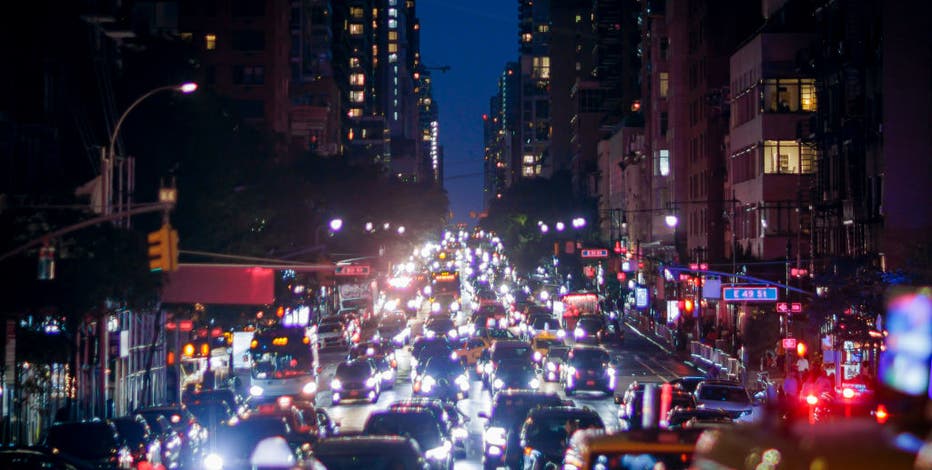The case for NYC congestion pricing, according to advocates

Support for NYC congestion pricing rally
MTA officials, as well as Gov. Kathy Hochul, rallied in Union Square to tout the benefits of the controversial New York City congestion plan. FOX 5 NY's Antwan Lewis has the story.
NEW YORK CITY - New York City’s congestion pricing plan, which would require most drivers to pay $15 to enter Manhattan’s central business district, is reviled by critics as "inadequate," "burdensome" and ‘outrageous."
Yet advocates insist it will make New York City a better place for all who live here.
Here’s what you need to know about the case they’re making:
Featured
NYC congestion pricing: How much will commuters pay, tolls, taxis, discounts
The plan shows how contentious and costly it will be for commuters, but Governor Kathy Hochul said it could’ve been worse.
What is congestion pricing?
The congestion pricing plan, which neighboring New Jersey has filed a lawsuit over, will be the first such program in the United States if it's approved by transportation officials early next year.
Featured
Who's fighting for congestion pricing exemptions in NYC?
Over 100 entities have been lobbying to ensure they are given exemptions from congestion pricing when it goes into effect.
Under the plan, passenger car drivers entering Manhattan south of 60th St. during daytime hours would be charged $15 electronically, while the fee for small trucks would be $24 and large trucks would be charged $36.
The proposal from the Traffic Mobility Review Board would include discounts for travel between 9 p.m. and 5 a.m. and for frequent low-income drivers. Government vehicles, such as municipal garbage trucks, would be exempt.
Why advocates say congestion pricing is good
MTA officials, as well as Gov. Kathy Hochul, rallied Tuesday morning in Union Square to tout the benefits of the controversial plan.
According to MTA officials, the plan is expected to generate $1 billion in revenue for the agency, enough to keep the wheels turning on it's buses, trains and subway cars.
Revenue from the tolls, projected to be roughly $1 billion annually, would be used to finance borrowing to upgrade the city’s mass transit systems, the MTA said.
According to officials, in addition to funding needed transit improvements, congestion pricing would result in improved air quality and reduced traffic.

A rally was held Tuesday morning in Union Square.
"Our first responders – ambulances, firefighters, emergency personnel – who are often stymied and delayed in getting to where they need to go, my friends, this is going to be transformative," Gov. Hochul said. "We’ll have the resources to invest in our system – a 110-year-old system, so it’s positioned for the next 110 years because of the courage here today. That’s what we’re fighting for.
Why opponents say congestion pricing is bad
Taxi drivers would pass a $1.25 surcharge onto their passengers for entering the congestion zone, while app-based ride-hail passengers would see a $2.50 surcharge. The drivers had pushed for a full exemption.

Congressmen push back against congestion pricing
Two congressmen, one from each side of the aisle, are stepping up their efforts to stop the MTA?s congestion pricing plan. FOX 5 NY?s Morgan Mckay has the latest.
"The city has already decimated the taxi industry with years of unregulated, unchecked competition from Uber and Lyft, and the MTA seems poised to land a final blow to the prospect of stability and modest survival," Bhairavi Desai, executive director of the New York City Taxi Workers Alliance, said in a news release. "If this proposal is implemented, thousands of driver families will get dragged back into crisis-level poverty with no relief in sight."
New Jersey Gov. Phil Murphy criticized the traffic mobility board's proposal as well.
"The Traffic Mobility Review Board’s recommended credit structure is wholly inadequate, especially the total lack of toll credits for the George Washington Bridge, which will lead to toll shopping, increased congestion in underserved communities, and excessive tolling at New Jersey crossings into Manhattan," Murphy, who filed a federal lawsuit over congestion pricing in July, said in a statement.
Is their congestion pricing anywhere else in the US?
Cities such as London and Stockholm have similar programs in place, but New York City is poised to become the first in the U.S.

NYC congestion pricing could begin in spring 2024
Richard Davey, president of the New York City Transit Authority, joined Good Day New York to discuss the latest with congestion pricing in New York City.
KAREN MATTHEWS, with the Associated Press, helped contribute to this report.



